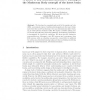Free Online Productivity Tools
i2Speak
i2Symbol
i2OCR
iTex2Img
iWeb2Print
iWeb2Shot
i2Type
iPdf2Split
iPdf2Merge
i2Bopomofo
i2Arabic
i2Style
i2Image
i2PDF
iLatex2Rtf
Sci2ools
ICANNGA
2007
Springer
2007
Springer
A Model of Non-elemental Associative Learning in the Mushroom Body Neuropil of the Insect Brain
We developed a computational model of the mushroom body (MB), a prominent region of multimodal integration in the insect brain, and tested the model’s performance for non-elemental associative learning in visual pattern avoidance tasks. We employ a realistic spiking neuron model and spike time dependent plasticity, and learning performance is investigated in closed-loop conditions. We show that the distinctive neuroarchitecture (divergence onto MB neurons and convergence from MB neurons, with an otherwise non-specific connectivity) is sufficient for solving non-elemental learning tasks and thus modulating underlying reflexes in context-dependent, heterarchical manner.
| Added | 08 Jun 2010 |
| Updated | 08 Jun 2010 |
| Type | Conference |
| Year | 2007 |
| Where | ICANNGA |
| Authors | Jan Wessnitzer, Barbara Webb, Darren Smith |
Comments (0)

